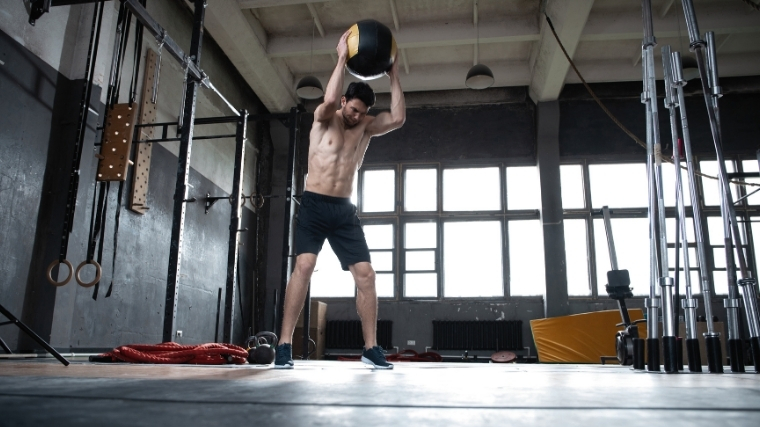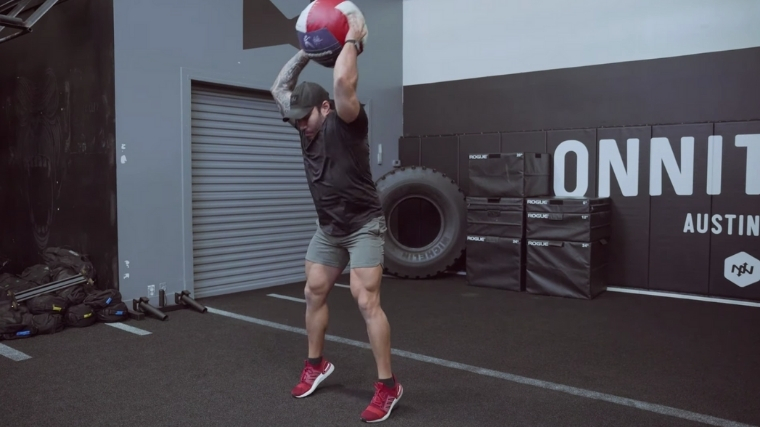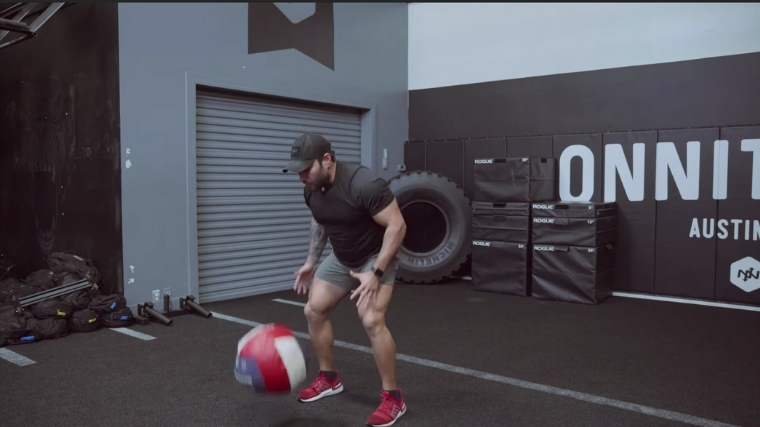Building muscle and gaining strength is all about control. Anytime you hoist a loaded barbell, you do so slowly. Up and down, up and down, up and down. On the other hand, becoming more powerful is all about exploding as quickly as possible. Few exercises are a better expression of full-body power than the medicine ball slam.
To do the move, you hold a medicine ball in both hands, bring it overhead, and then drive it down into the floor as hard as physically possible. It requires balance, coordination, mobility, and speed. Together, those elements, when trained, will help you produce more power — which is the result of mass times acceleration or how quickly you can move a load. But first, you need to learn how to do it and why you even should.
Benefits of the Medicine Ball Slam
Below, we’ll discuss what a medicine ball slam consists of (as there are many variations) and four main benefits you can gain from mastering them.

You’ll Be More Conditioned
To do a medicine ball slam, a lifter cleans the ball from the floor to overhead. Then the lifter practically performs an explosive vertical jump into a violent yet controlled slam, bringing his or her arms all the way up and then down toward the floor. In the process, the hips are extending forward and then hinging backward.
Don’t be mistaken; the medicine ball slam is a full-body exercise that recruits your core, shoulders, lats, and hips. These muscles work together to extend your body to load the ball and flex it to slam it. Repetitiously slamming a ball over and over is taxing on the muscles and your cardiovascular system. Do a few hard rounds of medicine ball slams each week, and better conditioning is all but guaranteed.
You’ll Have a Stronger Core
Your core sits at the center of your body, so it’s fully active throughout the entire ball slam. Muscles like the rectus abdominis are responsible for extending and flexing your torso, while the small stabilizer muscles, such as the traverse abdominis, help balance your body so you stay in one straight line. Some medicine ball slam variations require rotation, and the obliques are fully engaged when that happens.
You’ll Move Better
Exercises like the dumbbell bench press and front squat are great for building strength and movement in a specific pattern, but medicine ball slams are more fluid, forceful, and dynamic. When performing medicine ball slams, a lifter must promote force, react to stimuli, and repeat smoothly and simultaneously, much like what is needed throughout fitness and sport.
As a result, you’ll develop more coordination and balance, which helps you become reactionary in motion. This is particularly useful for athletes — competitive or recreational — as most sports have you move through multiple planes of motion constantly.
Your Warm-Ups Will Be Better
Before engaging in any hip hinge-based or upper body movement, you need to prime your muscles. The medicine ball slam is perfect for this. First, it engages all the relevant muscles — the lats during the downward slam, the hips throughout the entire movement, and the chest, shoulders, and chest during the slam.
By slamming a med ball before moves like the bench press or deadlift, you’re bettering the connection between the muscles in play and your central nervous system. So, when you finally do get under a barbell, your muscles and brain will already have an established connection.
You’ll also break a bit of a sweat and get some synovial fluid into your joints, so you’re not approaching any movement cold. And because med ball slams are relatively light, you won’t be too fatigued for the rest of your workout.
Related: Learn more about how the CNS and muscles work together in our article on how to increase strength.
How to Do the Medicine Ball Slam
Though the concept is simple, the medicine ball slam is a nuanced movement with many technical intricacies. Here’s a step-by-step guide on how to do the medicine ball slam.
Step 1 — Get Set

Stand with your feet shoulder-width apart, with your knees slightly bent. Hold a medicine ball at chest level with both hands.
Step 2 — Extend the Ball Overhead

Brace your core, extend your knees, and drive your hips forward while simultaneously lifting the bar overhead with your arms. The ball should be overhead, your hips should be thrust forward slightly, and you should be on your toes from the force of your drive.
Step 3 — Slam the Ball

[Read More: The Best Ab Exercises & Workouts, According to a CPT]
Now, squeeze your abs and drive your hips back to begin hinging forward. As your torso gets more parallel to the ground, swing your arms down as hard as you can. Once your elbows are extended, let the ball slam into the floor. Be careful that it doesn’t bounce back in your face.
Medicine Ball Slam Variations
Here are three medicine ball slam variations to alter your range of motion and the muscles worked.
Rotational Slam
This med ball slam variation has you pivot to one side and bring the ball down laterally. To do so, your core twists, and you perform a crunch to one side. During this variation, you’re not extending up and down but twisting more up and over. Your hips are still engaged as your dive them back during the bottom half of the movement.
Tall Kneeling Chest Pass
You’ll focus purely on your upper body here as you toss a ball as hard as possible against a walk from a kneeling position. Your core will also work to keep you stable in the kneeling position as you produce maximal force. This is a great move to do before any chest day.
Split Stance Medicine Ball Slam
By slamming a ball from a split stance — one leg staggered a foot or so behind the other — you won’t be extending your hips much, if at all during the slam. This means the core will be more engaged compared to a standard med ball slam. You’ll also get a little more leg activation due to the staggered stance and more extensive knee bend.
[Read More: The Best Leg Exercises for Your Next Leg Day]
Medicine Balls Vs. Slam Balls
If you’ve been training for even a little while, you may have run into two different types of slammable balls — medicine balls and slam balls. A medicine ball is usually lighter, larger in diameter, and will bounce back when you toss it. A slam ball is more compact and dense and will not bounce back. Slam balls can also be much heavier, sometimes even up to 100 pounds.
Typically, you’ll want to use a medicine ball for slams since they’re not as heavy, and the bounce back allows you to continue your reps more fluidly. Slam balls, on the other hand, are common for overhead tosses, carries, and squats. You can slam them, especially if you want to try a heavier slam, but you’ll have to scoop it up after each rep.
More Medicine Ball Content
There are many benefits to the medicine ball slam. Realize the move’s full potential by digging into more related content from BarBend.
- 5 Medicine Ball Exercises You Should Try That Aren’t Slams
- The Most Versatile Piece of Equipment You Might Be Forgetting to Use
Faetured image: OPOLJA/Shutterstock